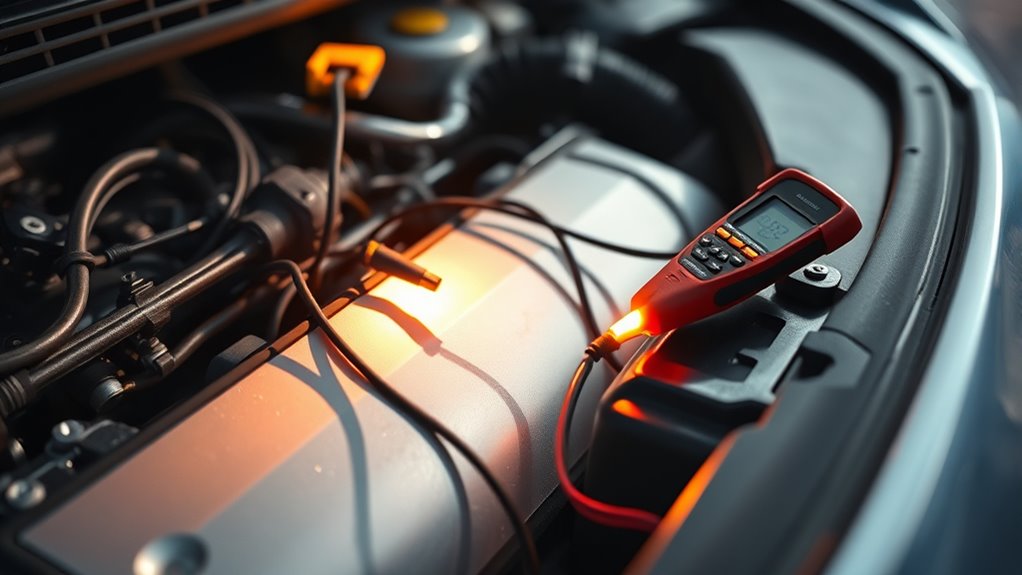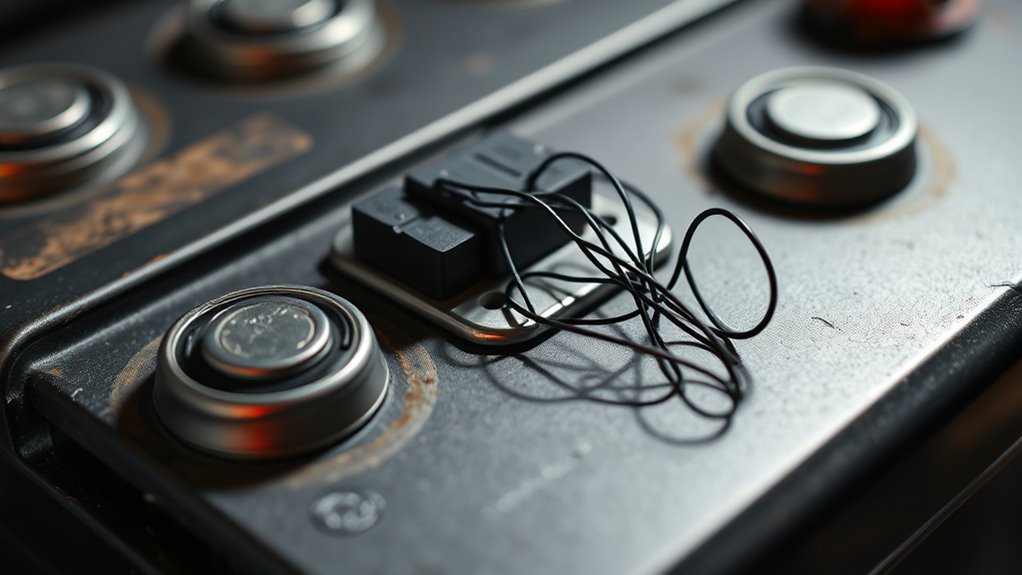Parasitic draw happens when electronic devices continue to use power even after your engine is off, which can slowly drain your battery over time. Common causes include wireless chargers, aftermarket alarms, or faulty wiring. This ongoing drain can weaken your battery, cause starting issues, and reduce its lifespan. To prevent this, regularly check your electrical system and disconnect unnecessary devices. Keep exploring to understand how to identify and minimize parasitic draw effectively.
Key Takeaways
- Parasitic draw occurs when electrical components drain power after the vehicle is off, impacting battery health.
- Continuous energy use from devices like wireless chargers and aftermarket alarms can shorten battery lifespan.
- Persistent parasitic draw can cause starting issues and increase the frequency of battery replacements.
- Regular testing with a multimeter helps identify and address sources of excessive electrical drain.
- Preventive measures include unplugging unused devices, activating sleep modes, and routine electrical system inspections.

Parasitic draw occurs when electrical components in your vehicle continue to use power even after the engine is turned off. This small but persistent drain can notably impact your battery’s health over time, leading to unexpected starting issues and the need for frequent recharges or replacements. Modern vehicles are packed with electronic features designed for convenience and security, but these can sometimes become culprits behind parasitic draw. For instance, wireless charging pads installed in your vehicle might seem harmless, but they draw power constantly to stay ready for use. Similarly, aftermarket alarms, especially those with advanced features like remote start or sensors, can keep circuits active even when your vehicle is parked, adding to the battery drain.
Parasitic draw from electronic devices and accessories can drain your car battery over time.
You may not realize it, but even devices that seem inactive, like a dashcam or a Bluetooth system, can contribute to parasitic draw if they’re wired improperly or have a malfunction. Wireless charging, while convenient, often remains powered on to provide quick access, which means it’s continuously pulling energy from your battery. If your vehicle’s charging pad isn’t designed with a power-saving mode, it can lead to a slow but steady battery drain. Aftermarket alarms, on the other hand, are meant to protect your vehicle, but they can sometimes be set up incorrectly or become faulty, causing them to stay active or “awake” longer than necessary. This constant activity, even when you’re not around, worsens the parasitic draw.
Additionally, research into sound healing science shows that certain frequencies can influence cellular regeneration and overall health, which highlights how persistent electrical activity may subtly impact your vehicle’s internal systems over time. You can minimize this drain by regularly inspecting and maintaining your vehicle’s electrical system. Start by identifying which components are wired directly to the battery and ensure they’re functioning properly. Many aftermarket alarms have a bypass or sleep mode—use it if available. For wireless charging pads, check if they have an auto-off feature or consider unplugging them when not in use. Most importantly, avoid adding unnecessary electronic accessories that are not essential, or opt for models that emphasize low power consumption.
Testing for parasitic draw involves a simple process: disconnect the negative battery cable and use a multimeter to measure the current flowing when the vehicle is off. If you find a higher-than-normal draw, start disconnecting aftermarket devices one by one to see which is responsible. If you’re unsure, consulting a professional can save you time and prevent accidental damage. Regularly checking and managing your vehicle’s electrical components ensures your battery lasts longer and keeps your vehicle reliable. By being mindful of how aftermarket alarms and wireless charging systems are wired and used, you can reduce parasitic drain and avoid unnecessary battery replacements.
Frequently Asked Questions
How Can I Prevent Parasitic Draw in My Vehicle?
To prevent parasitic draw in your vehicle, you should regularly perform battery maintenance and fuse testing. Start by inspecting and replacing any blown or loose fuses, especially those linked to accessories or aftermarket devices. Disconnect the battery when not in use for extended periods, and check for unusual electrical activity. Keeping your vehicle’s electrical system in good shape helps avoid unnecessary battery drain and guarantees reliable performance.
What Tools Are Best for Diagnosing Parasitic Draw?
To diagnose parasitic draw, you should use a multimeter testing device to measure the current flowing from your battery when everything’s off. Start by disconnecting the negative terminal and set your multimeter to amps. Then, pull fuses one at a time and observe the readings. When the current drops considerably, that fuse is linked to the source of the parasitic draw, helping you pinpoint the issue.
How Long Does It Take to Drain a Car Battery Due to Parasitic Draw?
It can take anywhere from a few days to a few weeks to fully drain your car battery due to parasitic draw, depending on your battery’s capacity and the electrical system’s draw. If your vehicle has a high parasitic load, battery longevity decreases markedly, leading to frequent dead starts. Regularly checking for parasitic draw helps maintain your battery’s health and keeps your electrical system functioning properly.
Can Electrical Mods Increase Parasitic Draw?
Yes, electrical modifications and aftermarket accessories can increase parasitic draw. When you add devices like aftermarket alarms, stereo systems, or lighting, they draw power even when your vehicle’s off. These upgrades can lead to higher parasitic draw if not properly installed or if they malfunction. Always guarantee your electrical modifications are compatible with your vehicle’s system and installed correctly to prevent unnecessary battery drain.
Is Parasitic Draw Common in All Vehicle Types?
Parasitic draw isn’t common in all vehicle types, but it can occur across various models, affecting vehicle compatibility and battery longevity. Modern vehicles with more electronics tend to have higher chances of parasitic draw, especially if electrical mods are added. Regularly checking for abnormal battery drain helps prevent unexpected battery failure. Maintaining your vehicle’s electrical system guarantees compatibility and helps extend the battery’s lifespan, regardless of your vehicle type.
Conclusion
Now that you understand parasitic draw and its impact on your battery, are you ready to take action? Regularly checking for drains and addressing issues promptly can save you from unexpected dead batteries. Think of your battery as a crucial partner; neglect it, and it’ll let you down when you need it most. So, isn’t it worth making a quick inspection part of your routine to keep your vehicle running smoothly?









